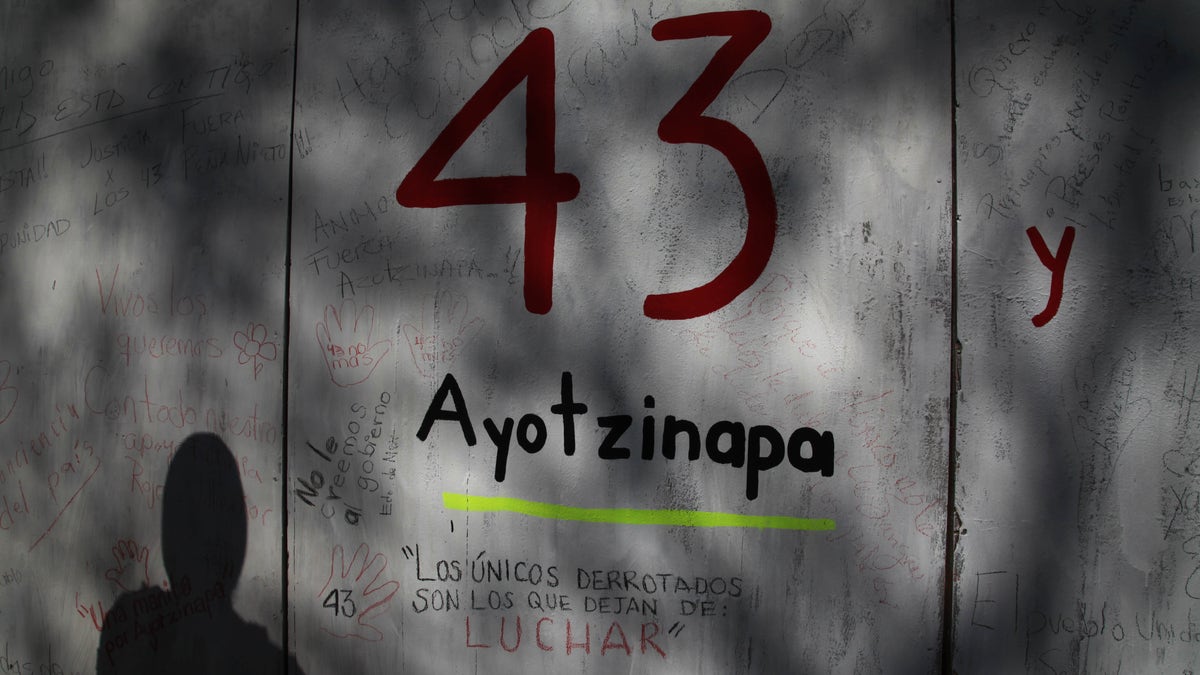
FILE - In this Dec. 28, 2014 file photo, the shadow of a demonstrator is cast on a wall with graffiti protesting the disappearance of 43 rural college students, in front of the Mexican Attorney General's office, in Mexico City. Mexican prosecutors said Tuesday, Jan. 20, 2015, that an Austrian forensics lab has been unable to find any more DNA that could be used by conventional means to identify charred remains that might be those of missing college students, but said they have authorized a final, unconventional effort. (AP Photo/Marco Ugarte, File)
The Attorney General’s Office of Mexico, known as the PGR, on Tuesday made public the findings of the team of forensic experts at the University of Innsbruck in Austria who have been attempting to identify the charred remains believed to belong to the group of 43 teaching college students who disappeared in the state of Guerrero on Sept. 26.
Sent on Jan. 12 and signed by Dr. Richard Scheithauer, the report concludes that “excessive heat" damaged the mitochondrial DNA in fragments of teeth and bones, "at least to the point that normal methods cannot be used to successfully analyze them."
The same team in early December identified the remains of one of the students, Alexander Mora, and it was hoped that more IDs would follow.
Authorities sent only 16 sets of remains to Austria, saying the rest were so badly deteriorated there was no chance of identifying them.
Failure to positively identify the bodies would be a setback for the government, which has struggled with widespread, often violent protests demanding that the students be returned alive, and with relatives' skepticism about the official line that they are dead.
- In Mexico City, a day of protest, a night of unrest over 43 missing students
- Mexico’s missing students impacts Acapulco tourism
- Kim Kardashian arrives in Reynosa, Mexico – as a piñata
- Mexico City demonstrators call for justice for missing students, Pres. Peña Nieto’s resignation
- The many faces of policing in Acapulco and Mexico
- In Mexico City, 43 missing students honored by teachers college marching band
- Best pix of the week
- Mexico continues to smolder over 43 missing students
- Mexico outraged over 43 missing students, thousands take to the streets in national strike
- Hunt for 43 ‘disappeared’ youths puts spotlight on Mexico’s long, and growing, list of missing
- As Mexico searches for 43 missing students, dozens of bodies turn up in mass graves
- Rick Sanchez: No justice for 43 missing students in Iguala, Mexico
- First ID of missing 43 Mexican students from charred remains found near garbage dump
- Opinion: Mexico, a nation at its breaking point
The students were detained and disappeared in the town of Iguala. Prosecutors say they were turned over to a drug gang that killed them and then incinerated their bodies on a fuel-fed pyre, before crushing the charred remains and dumping them in a river.
At this point, there is probably nothing the government can do that won’t draw someone’s ire.
The Innsbruck team has offered to use one last technique to identify the remains but says there is a large risk that the testing may destroy the samples without obtaining any useful information.
That technique is known as “massively parallel sequencing” (MPS), and it uses many computers in coordination to try to recreate the DNA.
The university said it would conduct the test free of charge and expected it to take another three months but could not give an exact date for results.
"The main risk is that the DNA extracted may be destroyed "without yielding any usable results, prosecutors cited the university as saying.
The PGR says it authorized the new round of testing.
Vidulfo Rosales, a lawyer representing families of the missing teachers college students, said prosecutors should have consulted the families of the missing students before making that decision.
"If these tests are done on the bone fragments, there could be practically nothing left," Rosales told local media. "This is going to have an impact on the parents' belief system. ... In rural tradition, mourning is highly symbolic, highly important."
Attorney General Jesus Murillo Karam has said the students were taken captive by police on orders of Iguala's then mayor, José Luis Abarca, who has since been detained after going into hiding.
The police and Abarca allegedly had ties to the Guerreros Unidos drug gang. Police allegedly turned the students over to Guerreros Unidos gunmen, who took them to a local dump, killed them and stacked their bodies on a pyre and used diesel, wood and old tires to burn them.
Authorities are holding more than 70 people in the case, which also forced the governor of Guerrero to resign.
Based on reporting by the Associated Press.
